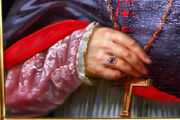In Western Christianity, rings are worn by bishops of the Roman Catholic, Anglican, Lutheran and other denominations. Eastern Orthodox bishops do not normally wear rings, but some Eastern Catholic bishops do.

St. Augustine of Hippo indeed speaks of his sealing a letter with a ring,[1] However, in a Decree of Pope Boniface IV (A.D. 610) we hear of monks raised to the episcopal dignity as anulo pontificali subarrhatis, while at the Fourth Council of Toledo, in 633, we are told that if a bishop has been deposed from his office and afterwards reinstated, he is to receive back stole, ring and crosier (orarium, anulum et baculum). St. Isidore of Seville at about the same period couples the ring with the crosier and declares that the former is conferred as "an emblem of the pontifical dignity or of the sealing of secrets".[2] The ring is strictly speaking an episcopal ornament conferred in the rite of consecration, and that it was commonly regarded as emblematic of the mystical betrothal of the bishop to his church. In the eighth and ninth centuries in manuscripts of the Gregorian Sacramentary and in a few early Pontificals (e.g., that attributed to Archbishop Egbert of York) we meet with various formulae for the delivery of the ring. The Gregorian form, which survives in substance to the present, runs in these terms: "Receive the ring, that is to say, the seal of faith, whereby thou, being thyself adorned with spotless faith, mayst keep unsullied the troth which thou hast pledged to the spouse of God, His Holy Church."

The ideas of the seal (signet ring), indicative of discretion and of 'conjugal' fidelity, dominate the symbolism attaching to the ring in nearly all its liturgical uses. The latter idea was pressed so far in the case of bishops that we find ecclesiastical decrees enacting that "a bishop deserting the Church to which he was consecrated and transferring himself to another is to be held guilty of adultery, and is to be visited with the same penalties as a man who, forsaking his own wife, goes to live with another woman."[3] Perhaps this idea of espousals helped to establish the rule, of which we hear already in the ninth century, that the episcopal ring was to be placed on the fourth finger (i.e., that next the little finger) of the right hand. As the pontifical ring had to be worn on occasion over the pontifical glove, it is a common thing to find medieval specimens large in size and proportionately heavy in execution. The inconvenience of the looseness thus resulting was often met by placing another smaller ring just above it as a keeper.[4] As the pictures of the medieval and Renaissance periods show, it was formerly quite usual for bishops to wear other rings along with the episcopal ring; indeed the 1882 edition of Caeremoniale episcoporum (Book II, viii, nn. 10-11) still assumed that this was likely to be the case. Custom prescribed that a layman or a cleric of inferior grade on being presented to a bishop should kiss his hand (called baciamano in Italian), that is to say his episcopal ring, and it was a popular misapprehension to suppose that an indulgence was attached to the act. In the Eastern Orthodox Church, though the hierarch (bishop) does not wear a ring, he holds his fingers in such a way as to form the initials associated with Jesus Christ, it is customary to kiss this symbol of Christ when receiving his blessing (which one should do upon being introduced). Another reason is that the right hand touches the Host during communion so once again, it is Christ being kissed, not the bishop. The right hand of Orthodox priests also is kissed for the same reason.
Episcopal rings, both at an earlier and later period, were sometimes used as receptacles for relics. St. Hugh of Lincoln had such a ring which must have been of considerable capacity. (On investiture by ring and staff, see Conflict of Investitures.) Traditionally, three rings were bestowed: the pontifical, the gemmed, and the ordinary. However, in recent years, most bishops have only received one ring for the sake of modesty in costs.
Modern rings for bishops have tended to be far simpler than those of earlier periods: most bishops today choose or are given as gifts wide gold bands with a Christian symbol (a cross, chi-rho, or crucifixion scene, for example), rather than a jeweled ring.